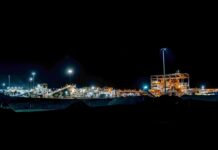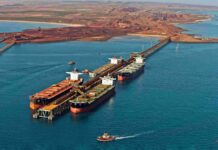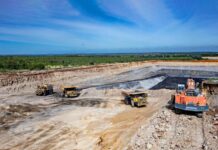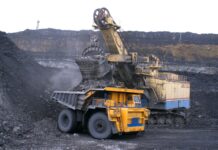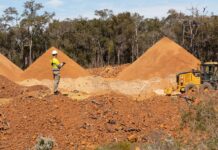Decarbonising the mining industry
With mining being Australia’s largest export industry — contributing $2.4t in resources export revenue over the past decade, as stated by the Minerals Council of Australia — it also accounts for a significant portion of the country’s greenhouse gas emissions.
Reported by the Climate Change Authority, Australia’s greenhouse gas emissions
totalled 467mt for the year ending June 30, 2023 — an increase of 4mt on the previous year.
The combustion of fossil fuels is Australia’s largest source of emissions, accounting for 81% of the national greenhouse gas inventory in 2023.
Australia, along with all countries that signed the Paris Agreement, has committed to the global goal of ‘holding the increase in the global average temperature to well below 2°C above pre-industrial levels’ and pursue efforts ‘to limit the temperature increase to 1.5C
above pre-industrial levels’.
To keep global warming to no more than 1.5°C, emissions need to be reduced by 45% by 2030 and reach net zero by 2050.
In an effort to decarbonise the country’s mining industry and meet the targets outlined in the Paris Agreement, mining companies have chosen to adopt new technologies, enhance energy efficiency and transition to renewable energy sources.
The Australian Mining Review speaks with Women in Mining & Engineering WA founder and president Catherine Lalut about how the mining industry can be decarbonised and the progress made so far.
“Decarbonising the mining industry is critically important for several reasons,” Ms Lalut said.
“The mining industry is a significant emitter of greenhouse gasses and reducing emissions is essential to combatting climate change.
“Worldwide, increasingly strict environmental regulations are being imposed to help reduce these emissions.
“Decarbonisation can lead to job creation in renewable energy sectors and improve community health from the reduced pollution.
“The transition to a low-carbon mining industry presents both economic opportunities (new business models) and challenges (workforce reskilling).”
Building sustainability
As companies look to reduce their environmental impact and carbon footprint, many are opting to invest in new technologies and train staff in sustainable practices in a bid to reduce emissions.
According to Ms Lalut, companies that don’t choose to decarbonise their operations face several risks, including investor pressure, financial losses and regulatory penalties.
“Mining can disrupt ecosystems and wildlife habitats. By minimising environmental impacts, companies help protect biodiversity and preserve natural habitats, ensuring survival of various species,” she said.
“Investors increasingly prioritise environmental, social and governance (ESG) factors and companies with high emissions may face divestment.
“Non-compliance with environmental regulations can lead to fines and legal issues, while increased operational costs can lead to financial losses.”
Progress so far
Some mining companies are making significant progress to achieve net zero emissions by 2050 and Ms Lalut said the progress made varies between each company and the region they operate in.

Studios) Women in Mining
& Engineering WA founder and
president Catherine Lalut.
“While there is a growing recognition of the need for decarbonisation, more consistent and accelerated efforts are required to meet the 2050 targets,” Ms Lalut said.
“Comparing decarbonisation progress across different mining regions can identify potential synergies and areas where knowledge sharing and collaboration can be beneficial.
“For instance, a region with advanced expertise in renewable energy technologies could share knowledge and best practices with a region still in the early stages of decarbonisation.”
BHP (ASX: BHP) is aiming to reduce operational emissions by at least 30% by 2030 and has a long-term goal of achieving net zero operations greenhouse gas emissions by 2050.
The company is doing this by shifting to renewable electricity and other low to zero greenhouse gas emissions electricity across its assets, as well as accelerating the deployment of battery electric vehicle technology for mining vehicles and equipment.
Fortescue (ASX: FMG) is heavily investing in green hydrogen projects and electric vehicles – and is aiming to achieve net-zero operational emissions by 2030.
In 2022, the company released its decarbonisation roadmap which aims to reduce operating costs by eliminating spending in diesel, natural gas and offsets.
Alternatively, Fortescue is taking steps to apply battery electric, green hydrogen and green ammonia to its operations where it can.
In FY23, Fortescue deployed its first battery electric haul truck, a prototype offboard power unit and 3MW fast charger to its Christmas Creek mine in WA, while a hydrogen fuel cell electric truck was delivered earlier this year.
“Companies that successfully integrate social and economic considerations into their decarbonisation strategies can serve as a strong positive example,” Ms Lalut said.
“For instance, a company might prioritise creating new jobs in the community during the transition to clean energy sources or invest in skills training to equip the workforce for new technologies.”
The path to decarbonisation must start at the top and the whole business needs to work collaboratively for a greener future.
“Decarbonisation is not just a technical challenge but a strategic and cultural one. It requires a commitment from the highest levels of leadership, substantial investment and a willingness to embrace change,” Ms Lalut said.
“The mining industry has the opportunity to lead by example in the fight against climate change and it’s essential that all stakeholders – governments, companies and communities – work together to achieve a sustainable future.”






